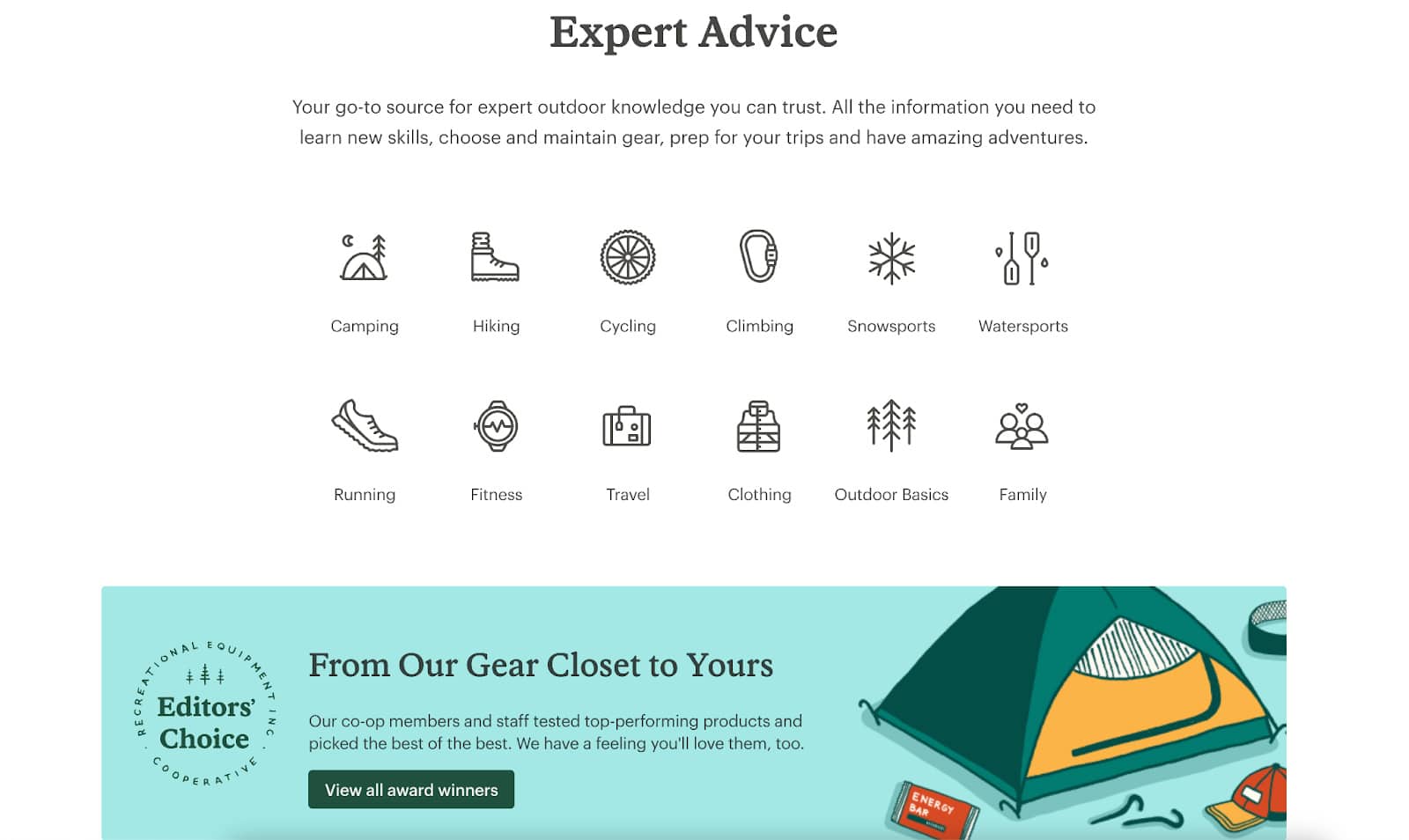After you’ve built your online store, your next goal should be to grow your business so you can increase profits. To grow an ecommerce business, you’ll need to identify your audience, bring traffic to your store, develop a customer retention strategy, build a community, and continuously test the market and your products.
Here’s a step-by-step breakdown of how to grow an ecommerce business:
Step 1: Identify Your Target Audience
Understanding your target audience is the first step in discovering how to grow your ecommerce business. It involves more than just demographics—it requires a deep dive into the interests, behaviors, and desires of your customers.
This understanding allows you to tailor your products and marketing strategies more effectively, ensuring that you’re not just reaching people, but the right people. It’s a strategic approach that maximizes your efforts and resources, positioning your business for growth by attracting and retaining customers who are most likely to engage with your brand.
Dive Deep Into Your Customer Base
Begin by examining the commonalities among your existing customers. What do they look for when shopping within your category? What do they like about your brand? What challenges do your products solve for them? Identifying these patterns not only helps in crafting your offerings but also in sharpening your marketing edge. Here are some tips:
- Create buyer personas: Craft semi-fictional representations of your ideal customers. These personas guide your growth efforts, ensuring your messaging resonates deeply with the audience you aim to captivate.
- Adopt a niche focus: Once you find patterns in your target audience’s preferences, zero in on a specific market that resonates with them. For example, if eco-friendly goods appeal to your buyers, then concentrate on expanding your eco-friendly product line and refine your messaging to highlight sustainability.
Engage & Learn
The key to a solid understanding of your target audience is active engagement. Where do they spend their online hours? What platforms do they prefer? Gathering this intelligence is pivotal.
Implement surveys, feedback mechanisms, and social media engagement to gain insights into your audience’s preferences and pain points. This continuous feedback loop not only nurtures your relationship with them but also informs product development and marketing strategy refinement.
Step 2: Bring Traffic to Your Store
After you’ve built your online store and identified your target audience, it’s time to bring in some sales. Unlike a physical store that benefits from natural foot traffic, your online store demands a strategic effort to attract and guide potential customers to you. Here are some strategies to improve your online visibility and attract more visitors.
Make Your Store SEO-friendly
The key to generating traffic is search engine optimization (SEO)—using practices to improve search engine ranking for terms (or keywords) that customers use when looking for your kind of business or product. A widely reported statistic indicates that 93% of website traffic comes from a search engine, and HubSpot reports that 75% of people never go past the first page of search results.
One thing is clear—your store needs to show up on the first page of search results.
Here are some SEO tips for your store:
- Use the Google Keyword Planner tool to guide you to your product’s correct list of most relevant keywords.
- Use descriptive, keyword-rich titles and meta descriptions for better click-through rates.
- Improve loading times and mobile responsiveness for ideal site speed.
- Optimize your product’s URL (example: https://www.yourstore.com/product-name) by making it short. Avoid using numbers like year or date.
- Use your product photos’ alt text to rank images in the image section of search engine results. Shopify has instructions for adding alt text to images.
Read our ultimate guide to ecommerce SEO.
It can be overwhelming to learn about SEO and keywords, especially if you are not tech-savvy. That’s why it is easier to go with ecommerce platforms that make SEO setup easy. Ecommerce platforms such as Shopify and BigCommerce have built-in SEO tools that allow you to optimize individual product pages.
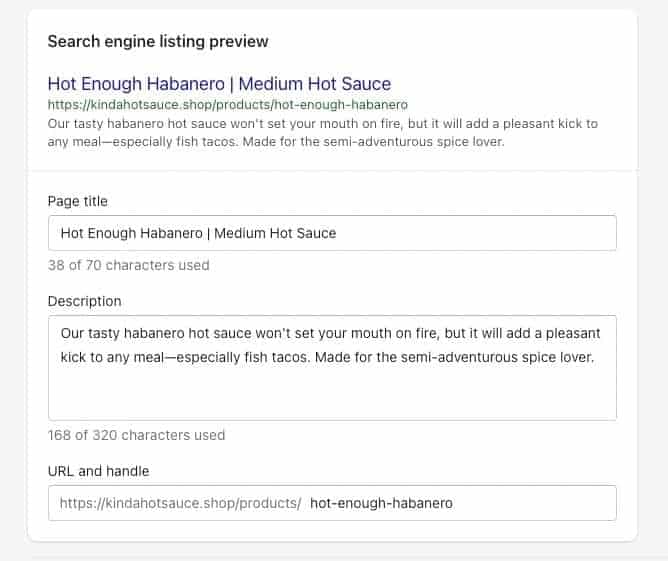
An example of a product page in Shopify where you can edit and preview an SEO listing. (Source: Shopify)
Your store is more likely to rank higher in search engine results by incorporating SEO keywords into your product titles and descriptions. This increased visibility leads to more site visits, improving the chances of more conversions.
If you’re unsure how to find SEO-friendly keywords or incorporate them into your store, check out this helpful guide on how to rank higher on Google.
Leverage Social Media Marketing
You’ll need to build brand awareness and excitement for your product to generate traffic to your store, and social media makes it easy for you. It’s generally the fastest and most cost-effective way to get the word out. You also have the option to invest in paid advertising. Still, as long as you practice tried and tested social media marketing strategies, you will be able to generate buzz about your brand—and create traffic to your ecommerce website.
Here are some tips on how to market your store on social media:
- Choose the right platform. Once you know your target market, identify which platform your target audience is most active on. For example, Instagram is a popular choice for brands with the millennial population as their target audience, whereas TikTok is great for reaching Gen Z.
- Develop a marketing plan. You don’t need just a social media account; you also need consistent, high-quality content. Without a marketing plan, you won’t be able to take your online traffic to the next level.
- Find out what your competition is doing and zoom in on high-performing content. You can then get ideas on how to position your brand and products in the social space.
- Partner with influencers. Work with social media influencers whose followers match your target audience and who share your brand values. This strategy boosts visibility and credibility quickly. Influencers can produce authentic content to highlight your products, effectively driving engagement and traffic to your store.
- Learn and improve. Use social media analytics to track the performance of your content placements. These will also help you strategize on paid ads and improve future promotions.
Over time, your efforts in building your social media community will pay off because it can be a space for your customers to ask questions, discover new products, learn your brand messaging, and even advocate for your business. Engage with your audience well, and you will eventually see healthy brand growth—not only in traffic.
Consider Paid Advertising
If you have the budget to invest in paid advertising, it can be well worth it. First, orient yourself on the costs of advertising on Google, Facebook, and other social media platforms. Second, if you have already searched for your store’s relevant keywords for SEO, you can use these keywords to redirect paid traffic to your online store too. Here are some of the most common and effective types of paid advertising you can use:
- Pay-per-Click (PPC) Advertising: A PPC campaign, like Google Ads, enables your site to feature at the top of search results in a promotional placement, bypassing the need for organic SEO ranking. PPC advertising is the process of creating paid ads that display alongside top search results based on keywords. It can be a smart short-term strategy for building brand awareness.
- Facebook & Instagram Ads: Unlike PPC advertising, Facebook advertising doesn’t show up based on search results. Your ads show up on users’ feeds based on demographics, behaviors, and other user data. Before you start running ad campaigns on Facebook or Instagram (both owned by Meta), you’ll need to set up a business account to sell on Facebook and sell on Instagram. This will give you access to Facebook’s Ads Manager to create posts and run campaigns for both platforms.
Find out which is best for your businesses: Google ads vs Facebook ads.
Use Analytics to Learn How Customers Find Your Store
Tools like Google Analytics track which channels your target customers are using most, so you can focus your marketing efforts on these platforms. For example, if you get a lot of traffic to your furniture store from a blog post about interior design and decorating, you should write more content on that topic. If your Facebook ads are converting more sales, it may be worth it to invest in more advertising.
To track seller activity better, make sure to do the following:
- Enable the enhanced ecommerce tracking feature for a wide range of insights on your seller activity when you set up Google Analytics with your store. If you use Shopify, review its step-by-step guide on setting up Google Analytics on its platform.
- Create segments on Google Analytics to form data-driven insights on your key buyer groups.
Step 3: Optimize for Conversions
Now that you have generated store traffic and improved your site’s navigation and product visibility, it’s time to make sure sales conversions happen. Shopping statistics show that cart abandonment gets in the way of 71.42% of shopping carts worldwide, most commonly caused by unexpected shipping, fees, taxes, and friction during checkout. To optimize sales conversions, consider doing the following:
Streamline Your Checkout Process
The checkout process is one of the biggest reasons for cart abandonment—particularly if it’s too hard to navigate, lacks security seals, or asks for too much information. Simplify your checkout process by employing these best practices:
- Use a clean design on your checkout page
- Ask for essential information only
- Offer guest or express checkout, ideally with one-click checkout like ShopPay
- Extend a range of payment methods
- Highlight options like free shipping and returns
- Make it easy to apply gift cards and discounts
- Add trust seals
- Give customers a clear path to support
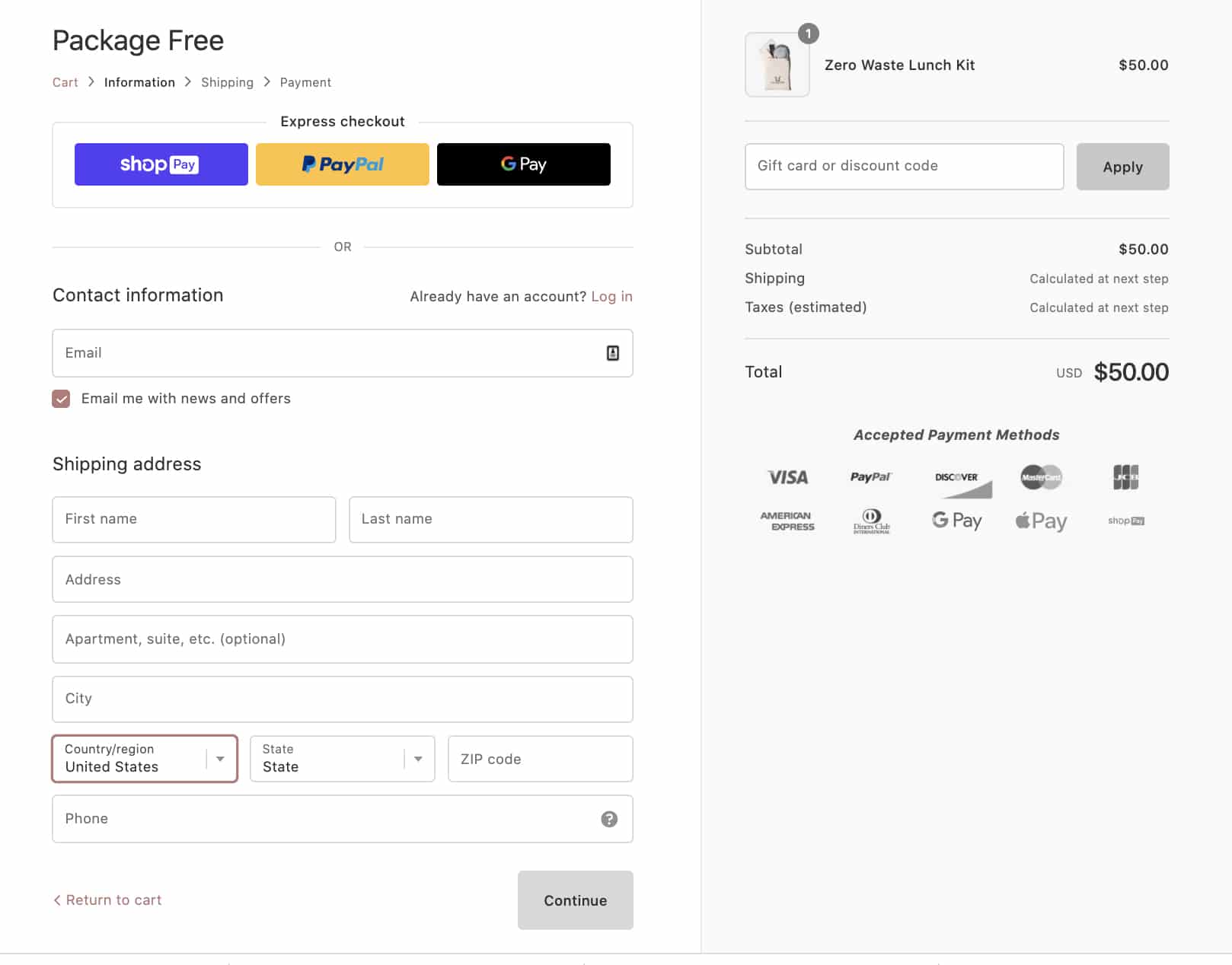
A perfect example of a streamlined checkout page is Package Free’s, which uses a Shopify store.
The sample checkout page above illustrates an excellent example of a distraction-free checkout page. It offers an express checkout option right from the start, along with different payment options and a security seal of trusted payment channels. Additionally, it only asks for essential information, such as a name and shipping address, and is transparent with taxes and shipping fees. Note that all of these can be done with very minimal clicks.
Read more checkout optimization tips.
Offer a Personalized Customer Experience
A commonly cited stat says that 91% of customers are more likely to buy from an online store that provides personalized experiences. You can offer a personalized experience by simply displaying more products relevant to the customer, which helps increase basket size and sales.
- Set up product recommendations or favorites based on user behavior (like purchase or browsing history)
- Display products or campaigns based on user location
- Offer add-ons and related product sales during checkout or on product pages
- Upsell, cross-sell, and down-sell (during and after checkout)
- Create a quiz that matches shoppers to a product based on their needs
Tip: Most ecommerce website builders like Shopify and BigCommerce offer third-party integrations to personalize the customer experience.
Build Buyer Trust With Product Reviews
Social proof in product reviews goes a long way to convince customers into buying a product. Product ratings boost your trust rating since customers rely on buyers’ feedback to assess product quality.
Here are some tips for using product reviews in your store:
- Indicate the average rating and number of reviews at the top of each product page and at the bottom, where you display the content of the reviews to increase the feedback’s visibility.
- Give buyers an incentive to leave a review by giving them a discount coupon that they can use on their next purchase once they leave a product review.
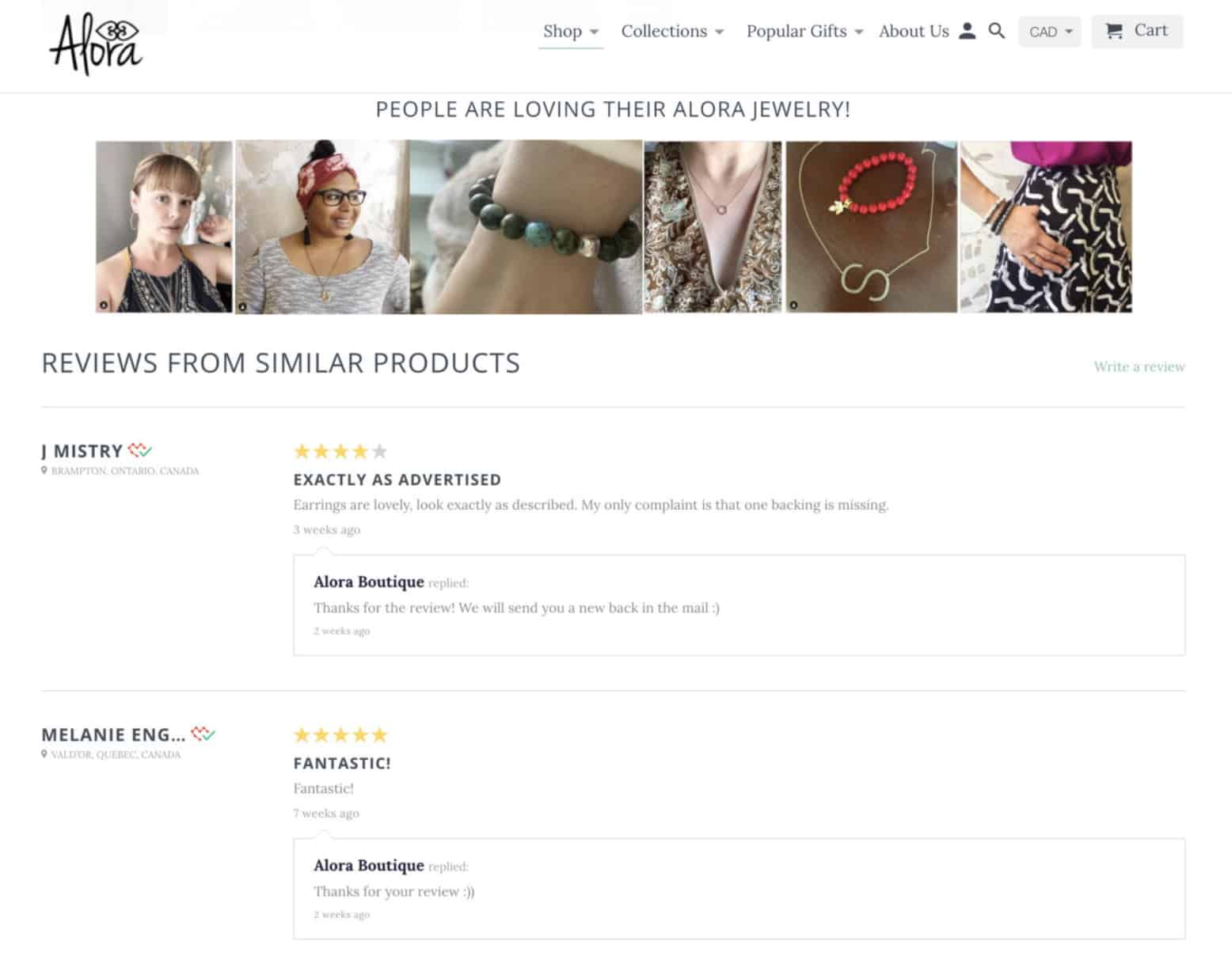
Alora.ca, a jewelry ecommerce store, has an effective review page that shows customer photos and star ratings for each review. Reviews from real customers are validated with an icon, and the brand can reply to each review.
Learn more about leveraging user-generated content (UGC) for ecommerce.
Enable Social Media & Marketplace Shopping
If you are active on social media, consider connecting your social media accounts to your store so that customers can buy directly from social media posts when they see something they like.
A few ways to do that are:
- Using a Square Online checkout link in your Instagram, Twitter, or Facebook post. You can direct customers to a simple checkout page so they can make purchases with a credit or debit card, Apple Pay, or Google Pay.
- Enabling Instagram Shoppable posts so that customers can make purchases right from their newsfeed without ever having to leave the app.
- Setting up a Facebook Shop by integrating your ecommerce store. You can keep tabs on inventory, purchases, and order fulfillment from your Shopify store and don’t have to monitor two website stores.
- Sell on TikTok Shop. Fifty-five million Americans in the US have shopped on TikTok so far. It is clearly the social channel to have a presence on these days. Learn how to sell on TikTok and check out our TikTok ecommerce strategy guide.
- Tapping into marketplaces since they provide a more extensive audience reach. Learn how to sell on Amazon, Walmart, and Etsy. Also, check out our tips for selling on Etsy.
When Alder & Green launched their online store using the Shopify platform in 2021, Cormac Folan (CEO and co-founder) shared with us that they used the many out-of-the-box integrations on Shopify to help set up shopping feeds and marketing integrations with Google, Facebook, and TikTok. By utilizing these integrations, their brand was able to get more exposure for their products and tag them on their social channels to help drive direct sales.
Price Competitively
Product pricing is something you need to figure out early on in your ecommerce operations. Pricing and additional costs are also one of the most significant factors in shopping cart abandonment. If you know how to price your products competitively and are transparent about the additional fees involved in purchasing a product from your store, you will most likely be able to convert site visitors into customers.
Related: Pricing Strategies + Examples
Keep Shipping Costs as Low as Possible
Baymard Institute found that 48% of US consumers abandon items in their cart because of extra fees like shipping. Most large retailers like Amazon offer free shipping, so it has become an expectation for most consumers. For small retailers, it can be a headache since shipping takes a considerable chunk in overhead costs. However, free shipping is undoubtedly doable without losing profit—learn how to offer free shipping on your products.
Recover Abandoned Carts
Cart recovery should be a feature in your ecommerce platform. Setting up abandoned cart recovery emails helps you interact with customers who don’t place or finish their orders to lure them back. You can customize your emails, add schedule triggers, and add discount codes to entice customers back to your store. About 45% of all abandoned cart emails are opened, with half of the click-throughs resulting in a purchase.
One of Shopify’s biggest advantages is having an abandoned cart recovery feature available even on its Basic plan, which costs $39/month (other ecommerce platforms offer the feature in higher-priced tiers).
Step 4: Consistently Publish Helpful Content
You might have the right social strategy, implement the correct SEO techniques, and optimize your product pages and website—but if you don’t put out helpful content consistently, your site traffic will dwindle and your sales will, too.
“If you want to grow your online store, you should have a useful, SEO-driven blog. Based on my experience, blogs are an excellent opportunity to connect with readers. And if the article has relevant keywords, it is more likely to rank higher in search engine results. Know your customers’ interests. Research their online buying behavior. If you try to understand your customers deeply, you’ll be able to publish blogs that meet their needs and wants.”
– Tristan Harris, Sr. Marketing Manager, Thrive Digital Marketing Agency
A content marketing strategy is crucial to help you grow your online store. The right type of content educates, informs, and engages with customers. At the minimum, your website pages and product detail pages should have helpful information. Along with content, your website should be optimized for good design and flow. Learn more about our ecommerce design tips.
A few ways to consistently publish helpful content include:
- Maintain a blog. Even with distrust in public information sources, 83% of US consumers still trust blogs for product recommendations over other content. Blogs serve three purposes: 1) They can help with your SEO strategy (drive traffic), 2) They can educate customers, promote products, and drive engagement, and 3) They can help establish your company’s authority and knowledge about the industry you operate in. Learn how to get your business blog started with our guide.
- Align messaging with your ecommerce strategy across all customer touchpoints. For example, if you are preparing for a storewide annual sale, you can conceptualize blog content that centers around gift guides and start posting similar content across your social platforms.
- Don’t forget about email marketing. It should be included when planning your content strategy. Include personalization, segmentation, and automation, if applicable. Ecommerce platforms can integrate with email marketing software, and there are platforms like Shopify that include email marketing in their subscription plans.
Step 5: Develop a Customer Retention Strategy
We’ve heard it before—it’s less expensive to retain a customer than acquire a new one. Bain & Company and Harvard Business School have found that “increasing customer retention rates by 5% increases profits by 25% to 95%.”
It is crucial to develop customer retention strategies to drive growth in any business, but more so in retail. In the ecommerce industry, here are some tangible ideas to help you improve customer retention.
Encourage Customer Accounts
Guest or express checkouts convert more sales because of speed and convenience. However, encouraging buyers to create store user accounts allows you to learn about their purchasing habits, engage with them better through email marketing, and develop a personalized customer experience for them—all of which drives them to purchase again and again. You can incentivize guest shoppers to create accounts by offering a one-time coupon or gift-with-purchase.
Develop a Customer Loyalty Program
Loyalty programs are customer retention programs in disguise. It’s a proven method to increase customer purchase frequency because it can motivate customers to buy more to earn reward points. While this feature can be built-in or integrated as an app with ecommerce platforms, you still need to learn how to develop an effective and rewarding loyalty program.
Provide Excellent Customer Service
According to HubSpot research, 93% of customers are likely to make repeat purchases with companies that offer excellent customer service. Excellent customer support is key to retention, brand advocacy and, eventually, more growth.
Here are some ways you can achieve great customer service:
- Create a contact page on your website with information on contacting your support team—ideally a phone number, email address, social media pages, and chat pop-up, if you have one.
- Add an easy-to-find FAQ page to help people get answers right away.
- Provide support at all stages of the shopping experience. For example, include hovering or pop-up boxes to general questions during purchasing, and follow-up emails post-purchase.
- Make your customer support channels visible from every page in your online store.
- More customers have started to prefer live chat support to be able to get an answer right away. Install a chat feature on your website so you can monitor it throughout the day.
- Adopt a generous return and refund policy. It might be conceived as a loss at first. Still, if you demonstrate sincerity and make it easy for customers to get refunds and return items, it will most likely prevent them from going to another store to purchase the same item. Learn how to write a refund policy.
Learn more about creating a customer service strategy.
Step 6: Measure Customer Retention & Set Benchmarks for Improvements
Once you have implemented a customer retention strategy, monitor your customer retention rate. The average retention rate for online businesses is around 35%. If your metrics show your retention rate is dipping, it’s an indicator to revisit your retention strategies and set guidelines for improvement.
Some ecommerce platforms (such as BigCommerce) have customer analytics that would have information about repeat customer rate, purchase frequency, average order value, customer lifetime value, and churn rate. These metrics all help you devise retention strategies better.
Step 7: Get Listed on Google Shopping
There are 8.5 billion searches in Google each day. Clearly, ranking in search results will be a definite way to boost your online store’s visibility. However, getting your products listed in Google Shopping will help increase product visibility and, consequently, overall online store visibility.
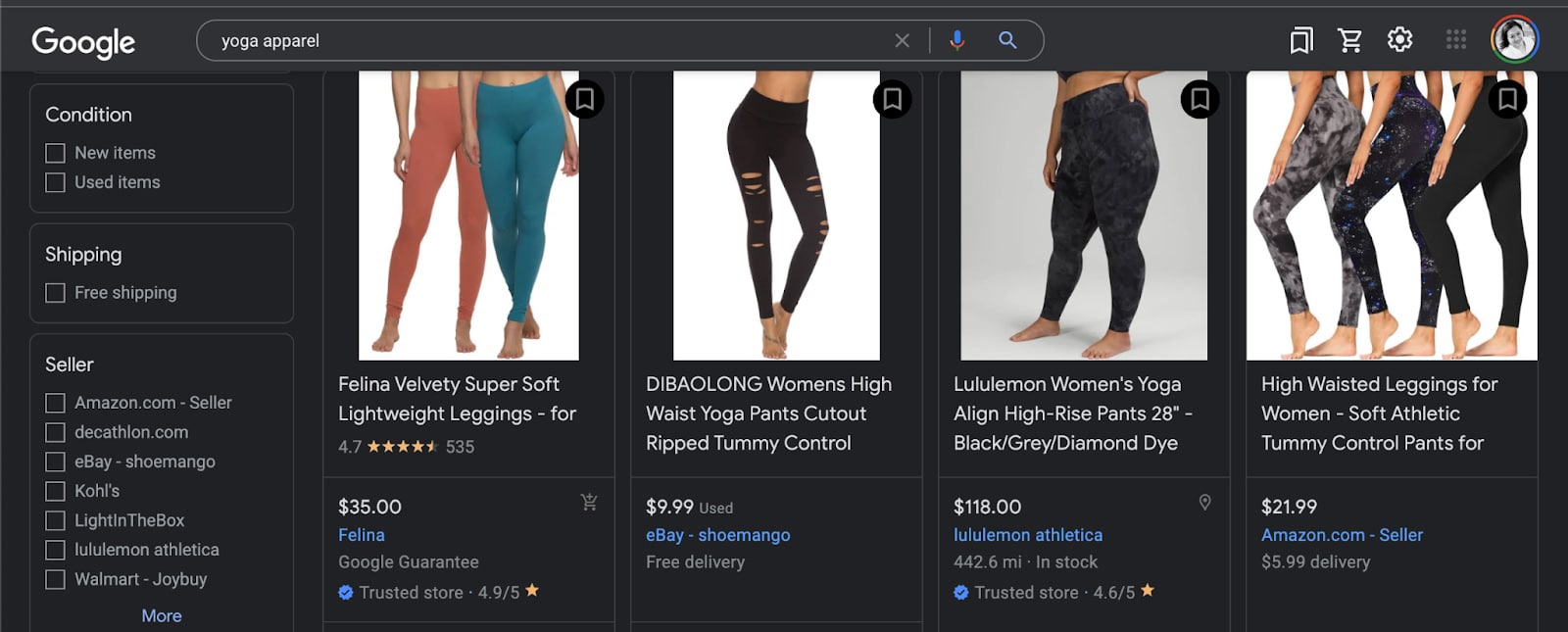
A Google Shopping ad includes a product image, the price, and your business or store name.
Investing in Google Shopping ads boosts your product’s visibility to more customers through a visually oriented comparison search engine. Your product appears in search results when it matches a search query, and you only pay when someone clicks on your ad.
It can take some time to set up a product data feed for Google Shopping since you need a Google Merchant Center Account and a Google Ads account. However, most ecommerce stores like Shopify and BigCommerce have built-in integrations that allow you to sync your products and get started on Google Shopping.
Step 8: Host Livestream Shopping Events
There is a growing interest in livestream shopping events among American consumers, especially Gen Z and millennials, and it’s an emerging trend you can take advantage of when discovering how to grow an ecommerce business. Livestream shopping gives you a chance to talk to your customers and answer questions real time, lending to engagement, sales, customer service, and brand awareness.
You can do livestream shopping events on social media channels like TikTok and Instagram, as well as selling on YouTube.
For an in-depth guide, read our article on livestream shopping.
Chocolate brand KitKat combined the power of livestream shopping with Facebook and Instagram ads when it launched its “Fill Your Break With Wonder” campaign. It hosted a Facebook Live event so that people could easily make a purchase when using the “Comment to Message” feature (this begins a Messenger conversation when someone comments on the livestream).
The campaign was impressive—it generated more than one-third of KitKat Chocolatory Australia’s annual sales, and it also increased brand awareness among 35- to 44-year-olds in Australia by 23 points.
Step 9: Build a Community
Building community among your customers helps develop customer loyalty, which then transforms your customers into advocates. Word-of-mouth endorsements will end up being organic and can certainly help your business in its marketing efforts. They can boost visibility in search results and create buzz around your products and events.
At its core, community building is about relationships with your customers. It encompasses customer service, social media engagement, and online store policies such as refunds and returns.
Here are some ways you can foster brand community:
- Be clear about your brand values. Display them prominently on your website, include them in your social messaging, and be vocal about causes you support. Shoppers say they spend their money with businesses whose values align with theirs.
- Leverage user-generated content among buyers. While UGC is mainly an ecommerce marketing strategy, it also helps build brand awareness and connect like-minded people who support your brand.
- Personalize the shopping experience. An estimated 60% of shoppers become repeat customers after a personalized shopping experience. Thanks to segmentation and automation, your ecommerce platform can help personalize recommendations, greet shoppers by their first name, and more.
- Bring the community together in person. Host tailored events in your local area or at industry conferences, and engage attendees with giveaways and samples. A sportswear brand could offer a yoga class, while a pet goods retailer might organize a dog training session. These targeted gatherings not only showcase your products but also build a community around your brand.
Step 10: Continuously Evaluate Your Product & Markets
Once you have your growth strategies in place, it doesn’t stop there. Simply rinsing and repeating the same strategies can be a cause of downfall too—it’s essential to evaluate your products and growth strategies frequently. These include testing your products, offers, and markets.
Test Your Product Mix
Developing new products or improving your existing ones should be part of your finding out how to grow an ecommerce business. While you may have needed more time to do market and product research before launching, now you have the opportunity to tap into your most valuable asset when it comes to developing new products—your customers.
To reduce the risk of investing in new inventory, try testing out new offerings by utilizing dropshipping first. Then, if a product or category performs well, you can consider stocking it traditionally.
Scrambled merchandising is another option that involves mixing in unrelated or off-brand products that aren’t associated with your original brand or selection. It’s most often used to test out the introduction of new products, reach new customers, offset seasonal slumps, and meet unmet demands in your target market.
Test Your Promotional Offers
There are many promotions you can do with your online business, such as product bundling, discounts, coupons, giveaways, and more. Remember that promotions are not just done to increase sales but to drive traffic, increase engagement, and raise brand awareness. Plus, they can function as an inventory management tool as well.
Here are some ways to test your promotional offers:
- Run contests and giveaways. These are an excellent way to grow your social media accounts and your email list. For example, you can run a giveaway and one of the mechanics is to follow your social media channel such as Instagram or Facebook. Likewise, you can also ask them to enter their email address to have a chance at winning.
- Cross sell and upsell. You can do this by showing related products in your product pages or offering a discount when buying related products. Explore more of our cross-selling strategies in our guide.
- Run “buy one, get one” (BOGO) promotions, limited time sale items, free gift items. Limited time discounts usually incite FOMO (fear of missing out) in consumers, resulting in more sales.
Read our list of 19 promotion ideas to attract more customers for additional ideas.
Expand Into New Geographical Markets
The internet, as a global platform, removes the barriers to buying and selling within physical or country borders. For online stores poised for growth, incorporating tests in new markets—especially different countries—should be a strategic part of your expansion plan.
If you are keen to test new markets, make sure to do your research on regulations per country, check if your ecommerce platform has the ability to localize depending on language and currency, and verify if your payment processor is capable of accepting payments in the country’s local currency.
Also consider logistical options like local international fulfillment vs cross-border shipping to ensure your sales stay profitable without losing international customers to long delivery delays.
Frequently Asked Questions (FAQs)
These are some of the most common questions we encounter about how to grow online businesses.
To attract ecommerce customers, use a robust SEO strategy for visibility, create engaging content on social media for brand awareness, and offer promotions or incentives like discounts or free shipping for new buyers. Positive reviews and user-generated content are also crucial for building trust and drawing in shoppers.
Discovering how to grow an ecommerce business with little to no budget focuses on using free tools and platforms for marketing and sales. Utilize social media platforms to engage with your audience and create community-driven content. Implement SEO best practices to drive organic traffic. Encourage word-of-mouth through exceptional customer service. Also, consider dropshipping to expand your product offerings without upfront inventory costs.
Bottom Line
In building a successful ecommerce business, you need to develop both short- and long-term plans. These involve incorporating analytics, crafting marketing strategies, enhancing your buyer’s shopping experience, and focusing on delivering excellent and prompt customer support.
It can be taxing to incorporate these into the business without adding on to your time and overhead expenses. Going with ecommerce platforms that provide built-in tools such as one-page checkouts, abandoned cart recovery, and third-party integrations make it easier for you to roll these enhancements out.
Shopify is our top-recommended ecommerce platform for SMBs finding out how to grow an online business. It provides you with tools to compete with ecommerce giants such as product reviews, live customer chat, and thousands of third-party integrations—and that’s just scratching the surface. With several pricing plans available, you can start a small online business and grow that to an ecommerce enterprise. Give Shopify’s 14-day free trial a run—no credit card required.

